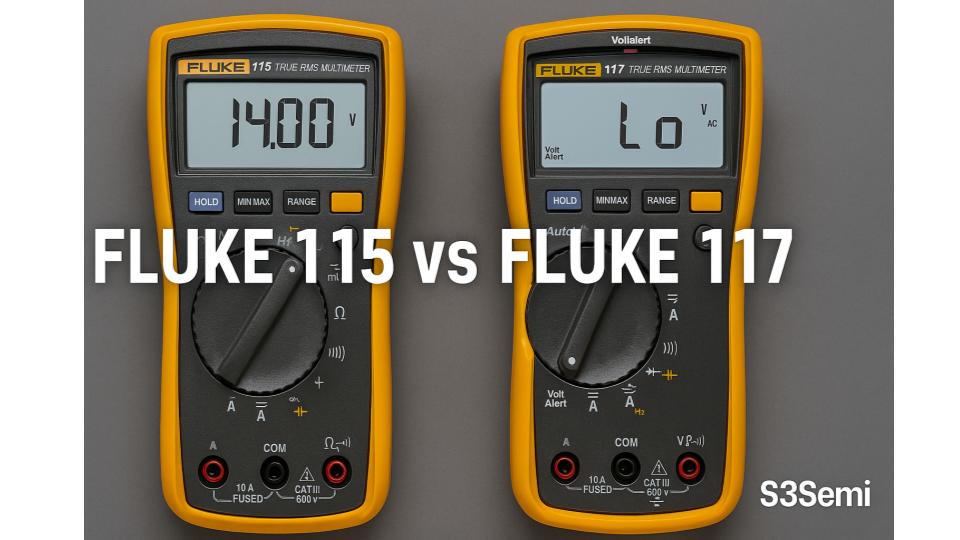Fluke multimeters are known for their accuracy, durability, and ease of use. Two popular models in Fluke’s compact series are the Fluke 115 and the Fluke 117. At first glance, they look almost identical — but they’re designed for slightly different users.
🏷️ Fluke Multimeter Deals ⭐⭐⭐⭐
If you’re wondering which one is right for you, this guide breaks down the key similarities, differences, pros, and cons.
📊 Comparison Table: Fluke 115 vs Fluke 117
| Feature | Fluke 115 | Fluke 117 |
|---|---|---|
| True-RMS | ✅ | ✅ |
| Voltage Measurement | Up to 600V | Up to 600V |
| Current Measurement | Up to 10A | Up to 10A |
| Resistance, Continuity, Capacitance | ✅ | ✅ |
| Frequency Measurement | ✅ | ✅ |
| Non-Contact Voltage Detection | ❌ | ✅ (VoltAlert) |
| LoZ (Ghost Voltage Elimination) | ❌ | ✅ |
| AutoVolt (AC/DC Selection) | ❌ | ✅ |
| Display | Backlit | Backlit |
| Safety Rating | CAT III 600V | CAT III 600V |
| Best Use | General-purpose field work | Electrician troubleshooting |
| 💳 Pricing | 💲 Check Price | 💲 Check Price |
📋 Overview of the Fluke 115
The Fluke 115 is marketed as the “Field Service Technician’s Multimeter.” It’s a versatile tool suitable for a wide range of applications, including general electrical and electronic work.
Key Features:
- True-RMS for accurate measurements on non-linear loads.
- Measures AC/DC voltage (up to 600V).
- Current measurement up to 10A.
- Resistance, continuity, frequency, and capacitance measurement.
- Large backlit display.
- Safety rating: CAT III 600V.
Best for: Technicians, engineers, and hobbyists who need a general-purpose, reliable multimeter.
📋 Overview of the Fluke 117
The Fluke 117 is designed as the “Electrician’s Multimeter.” It includes all the features of the 115 but adds some electrician-focused functions for commercial and residential environments.
Key Features:
- True-RMS accuracy.
- Measures AC/DC voltage (up to 600V).
- Current measurement up to 10A.
- Resistance, continuity, frequency, and capacitance measurement.
- VoltAlert™ non-contact voltage detection.
- LoZ (Low Input Impedance) to eliminate ghost voltages.
- AutoVolt automatic AC/DC selection.
- Large backlit display.
- Safety rating: CAT III 600V.
Best for: Electricians and building technicians who need quick, safe, and convenient testing in wiring systems.
👍 Pros & Cons of Each
Fluke 115
Pros:
- Reliable and accurate True-RMS performance.
- Compact and easy to carry.
- Slightly more affordable than the 117.
- Great for general-purpose electrical and electronic work.
Cons:
- No non-contact voltage detection.
- No LoZ function (ghost voltage readings possible).
- Lacks AutoVolt convenience.
Fluke 117
Pros:
- Includes VoltAlert non-contact voltage detection.
- LoZ function eliminates ghost voltages.
- AutoVolt saves time by auto-selecting AC/DC.
- Tailored to electricians and building service environments.
Cons:
- Slightly more expensive than the 115.
- Features may be unnecessary for hobbyists or light-duty users.
🏁 Which One Should You Choose?
- Choose the Fluke 115 if you’re a field technician, engineer, or hobbyist who needs a solid, general-purpose multimeter without extra electrician-focused features.
- Choose the Fluke 117 if you’re an electrician or building technician working in residential or commercial wiring. The added functions like VoltAlert, LoZ, and AutoVolt make troubleshooting faster, safer, and easier.
Both are excellent, compact multimeters built with Fluke’s trademark accuracy and durability — but the 115 is better for general use, while the 117 is optimized for electricians.




